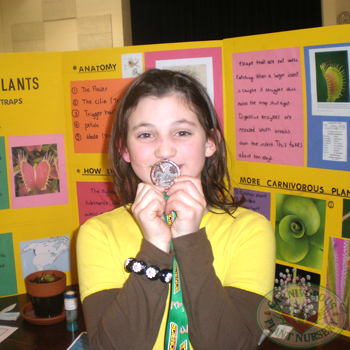
Carnivorous Plant Science Project Considerations
Carnivorous Plant Science Project Considerations
Be realistic. Here are some practical considerations to think about before you begin a project using carnivorous plants.
1. Poor Growing Will Foil Your Experiment.
Though the rules for growing carnivorous plants are few, they are strict. If you cannot grow carnivorous plants well, you may be setting yourself up for frustration and a failed experiment. It would be a shame to have your plants die after spending weeks or months on an investigation. If your plants are grown under poor conditions or under stress, you may not see the effects of the variable you are testing or worst the details of your investigation may be meaningless because you are using improper light, the wrong water, or soil to grow your plants. You will not know if the results you get are from your experiment or just plain poor growing conditions, or unhealthy plants. Read the section on growing carnivorous plants carefully and follow them well, if you want experimental success not to be foiled by poor growing. Be sure to start with strong healthy plants.
2. Select the Right Plants
Many carnivorous plants, including the Venus Flytrap, are slow growers. They are not good subjects for a project that takes several weeks or months to investigate. Exploring the effects of light, fertilizer, type of food, etc. on growth may take four to six months or more. You may be better off using a fast growing carnivorous plant such as the Cape Sundew, Drosera capensis or the Spatulate Sundew, Drosera spatulata. These two sundews grow fairly fast, and are easy plants in normal household conditions. You can see and compare growth results in a few weeks or months. If your heart is set on investigating with Venus Flytraps, then choose a topic dealing with the traps and how they close. A single flytrap with several good traps can give you good results in just a few minutes. Several flytraps can give you dozens of data points quickly. Consider a question such as, “Does the time between touching the trigger hairs twice have an effect on the speed of closure?”
3. Order Your Plants Well Ahead
Most suppliers provide plants that are bare-root, and shipped in damp sphagnum. This is a great way to ship carnivorous plants and the plants will begin growing once they are placed in good growing conditions. However, such handling and repotting can set the plant’s growth back about three weeks or more. It may be several weeks before you can actually begin your investigations. Plan ahead. We can ship plants in their pots, ready for your investigation, just let us know when you order them.
4. Consider Plant Dormancy
Some carnivorous plants like the Venus Flytrap, most pitcher plants, and some sundews enter a winter rest period. During this time the plants die back to a smaller size, have fewer and smaller or no traps, and are slow growing or show no growth at all. If there are traps, they are often very slow to respond or show no response. This makes it difficult to conduct experiments during the winter, when many science projects are due. Some plants and cultivars are good winter subjects. They show little or no dormancy. We can offer great suggestions on plant selection to help you avoid disappointment.
5. Select Large Plants
There are many reasons why you should use large plants in your investigations. Large established plants are harder to kill. They are easier to grow. They are easier to see the details of trap structure, trapping or digestion. They are easier to photograph. This is particularly useful advice when experimenting with Venus Flytraps or Pitcher Plants. Since sundews and butterworts grow much quicker, it may not be as important with them, though larger plants are always easier to manage.
